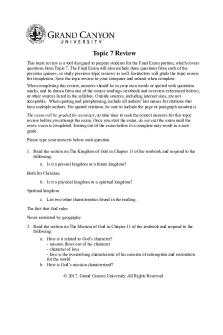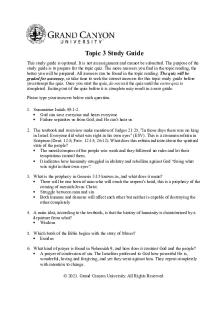CWV 101 RS T1Study Guide Online PDF

| Title | CWV 101 RS T1Study Guide Online |
|---|---|
| Author | Hailey Alexis |
| Course | Christian Worldview |
| Institution | Grand Canyon University |
| Pages | 4 |
| File Size | 193.7 KB |
| File Type | |
| Total Downloads | 48 |
| Total Views | 130 |
Summary
Download CWV 101 RS T1Study Guide Online PDF
Description
Topic 1 Study Guide This study guide is optional. It is not an assignment and cannot be submitted. The purpose of the study guide is to prepare for the topic quiz. The more answers you find in the topic reading, the better you will be prepared. All answers can be found in the topic reading. The quiz will be graded for accuracy, so take time to seek the correct answers for this topic study guide before you attempt the quiz. Once you start the quiz, do not exit the quiz until the entire quiz is completed. Exiting out of the quiz before it is complete may result in a zero grade. Please type your answers below each question. 1. List three analogies for worldview used in Chapter 1 of the textbook. Foundation of a Building: Worldview beliefs are also like a foundation of a building. They form the basis that supports and gives shape to the entire structure that is upon them. Just as the foundation of a building is often hidden from view, core worldview beliefs can be below the surface as well. With the foundation in place, the structure above begins to take shape in a way that is consistent with the foundation. In the same way, worldview beliefs are the foundation of values, attitudes, and actions that will be built upon it.
A Jigsaw Puzzle A worldview is also like a jigsaw puzzle (Cosgrove, 2006). The pieces of a jigsaw puzzle fit together to form a large whole. If pieces from a different puzzle are added to the puzzle box, they would not fit within the puzzle unless they were forced. This would make an awkward and confusing puzzle. Worldview beliefs fit together and make sense together, like a puzzle. Worldview beliefs come together, align with each other, and form a larger whole. If one picks and chooses beliefs from different worldviews, those beliefs can clash, misalign, and can form a confusing whole, like trying to combine pieces from two different puzzles.
An Overarching Story Finally, each worldview functions like an overarching story that enables individuals to gather various data and experiences into a coherent scheme that makes sense. This analogy is more complicated than the others, but it draws out the fact that various aspects of individual experience, or one's individual story, can be interpreted only in light of an overarching story about reality. In this way, a worldview offers a grand narrative of the world that enables individuals to grasp the significance of their individual story as it unfolds.
© 2020. Grand Canyon University. All Rights Reserved.
2. List the various definitions and descriptions of worldview found in the textbook and overview. A worldview is a foundational set of assumptions to which one commits that serves as a framework for understanding and interpreting reality and deeply shapes one's behavior. This definition can be divided roughly into four key parts:
A set of assumptions, Commitments, A framework, and How it impacts behavior.
Ronald Nash (1999) defined worldview as "a conceptual framework, pattern, or arrangement of a person's beliefs. The best worldviews are comprehensive, systematic, and supposedly true views of life and the world" (p. 13). One can note the key terms in the approach to worldview, such as conceptual, framework, and beliefs. Nash's (1999) definition focuses on the mind and the assumptions that make up worldview and that drive beliefs, and his approach is more philosophical in nature. Kenneth Samples (2007) defined worldview as "how one sees life and the world at large" (p. 20). Samples focused primarily on how worldview affects one's perspectives. Though each person holds to his or her worldview with commitment, Samples (2007) also emphasized that one's worldview commitments could be incorrect or could rest on faulty assumptions. James Sire's (2004) definition serves as a more comprehensive picture of worldview, attempting to encompass as many elements of worldview studies as possible: A commitment, a fundamental orientation of the heart, that can be expressed as a story or in a set of presuppositions (assumptions which may be true, partially true, or entirely false) which we hold (consciously or subconsciously, consistently or inconsistently) about the basic constitution of reality, and that provides the foundation on which we live and move and have our being. (p. 122)
3. Match the following worldview terms (Atheism, Pantheism, Theism, and Deism) with the correct description below. a. Belief in a personal and relational God who created and sustains all that exists: THEISM b. Belief in a God who created all things but is not relational or involved in the world: DEISM c. Belief that "all is God" and in a strong sense of spiritualism but not in a personal God: PANTHEISM 2
d. Belief only in the natural or physical realm with no spiritual or supernatural: ATHEISM
4. According to Chapter 1 in the textbook and Topic 1 Overview, which worldview families use both faith and reason? ALL OF THE FAMILIES 5. What kind of person does James 1:26 speak about? Those who consider themselves religious and yet do not keep a tight rein on their tongues deceive themselves, and their religion is worthless. 6. Please describe several key themes presented in Proverbs 8:10-11. There is nothing on earth more important that God's instruction and the wisdom that comes from Him. (Compared to silver, gold, and rubies) 7. According to The Beginning of Wisdom, what is the definition of faith?
8. Briefly describe the three worldview tests. 1. The Coherence Test checks the internal consistency of a worldview to see if one's specific values and beliefs contradict any other beliefs within the worldview. 2. The Correspondence Test examines how well a worldview corresponds to reality. It evaluates evidences and experiences to see if the worldview matches with what one perceives in the real world. 3. The Practical Test evaluates a worldview's livability. Does the worldview bring satisfaction as one faces life's challenges, or is it found to be lacking. 9. Match the following worldview elements (ultimate reality, nature of the universe, human nature, knowledge, ethics, and purpose) with the correct question below: a. Is there absolute truth? KNOWLEDGE b. Is there a God? ULTIMATE REALITY c. How do we know right from wrong? ETHICS d. Is there a spiritual part to the universe? NATURE OF THE UNIVERSE e. Does life have meaning? PURPOSE f. Are humans merely higher orders of mammals? HUMAN NATURE
3
10. When discussing worldviews, what is the difference between an open system and a closed system? An open system says that there is a spiritual force outside of social interaction while a closed system says there is no outside force.
Sources to use for this study guide: Hiles, J., & Smith, A. F. (2020). Evaluating wisely. In Grand Canyon University (Ed.), The beginning of wisdom: An introduction to Christian thought and life (3rd ed.). Retrieved from https://lc.gcumedia.com/cwv101/the-beginning-of-wisdom-an-introduction-tochristian-thought-and-life/v3.1/#/chapter/2 Topic 1 overview. (2020). CWV-101: Christian Worldview. Phoenix, AZ: Grand Canyon University. Waddell, J., & Jibben, J. (2020). Seeking wisdom. In Grand Canyon University (Ed.), The beginning of wisdom: An introduction to Christian thought and life (3rd ed.). Retrieved from https://lc.gcumedia.com/cwv101/the-beginning-of-wisdom-an-introduction-tochristian-thought-and-life/v3.1/#/chapter/1
4...
Similar Free PDFs

CWV 101 RS T1Study Guide Online
- 4 Pages

CWV 101 RS T1Review Online
- 4 Pages

CWV 101 RS T6Review Online
- 4 Pages

CWV 101 RS T7Review Online
- 3 Pages

CWV 101 RS T1Review Online
- 4 Pages

CWV 101 RS T3Review Online
- 4 Pages

CWV 101 RS T7Review Online
- 4 Pages

CWV-101-RS-T2Review-Online
- 4 Pages

CWV 101 RS T2Review Online
- 4 Pages

CWV-101-RS-T1Review-Online
- 3 Pages

CWV 101 RS T2Review Online
- 4 Pages

CWV 101 RS T5Review Online
- 3 Pages

CWV 101 RS T7Review Online
- 4 Pages

CWV 101 RS T6Review Online
- 4 Pages
Popular Institutions
- Tinajero National High School - Annex
- Politeknik Caltex Riau
- Yokohama City University
- SGT University
- University of Al-Qadisiyah
- Divine Word College of Vigan
- Techniek College Rotterdam
- Universidade de Santiago
- Universiti Teknologi MARA Cawangan Johor Kampus Pasir Gudang
- Poltekkes Kemenkes Yogyakarta
- Baguio City National High School
- Colegio san marcos
- preparatoria uno
- Centro de Bachillerato Tecnológico Industrial y de Servicios No. 107
- Dalian Maritime University
- Quang Trung Secondary School
- Colegio Tecnológico en Informática
- Corporación Regional de Educación Superior
- Grupo CEDVA
- Dar Al Uloom University
- Centro de Estudios Preuniversitarios de la Universidad Nacional de Ingeniería
- 上智大学
- Aakash International School, Nuna Majara
- San Felipe Neri Catholic School
- Kang Chiao International School - New Taipei City
- Misamis Occidental National High School
- Institución Educativa Escuela Normal Juan Ladrilleros
- Kolehiyo ng Pantukan
- Batanes State College
- Instituto Continental
- Sekolah Menengah Kejuruan Kesehatan Kaltara (Tarakan)
- Colegio de La Inmaculada Concepcion - Cebu

